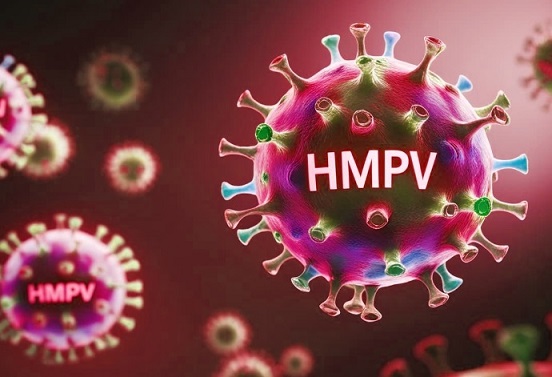Nikhil Prasad Fact checked by:Thailand Medical News Team Jan 15, 2025 10 months, 3 weeks, 13 hours, 20 minutes ago
Medical News: Human metapneumovirus (HMPV) is a respiratory virus that affects people of all ages, particularly children, the elderly, and those with weakened immune systems. This virus belongs to the Pneumoviridae family and is closely related to the respiratory syncytial virus (RSV). While most people are exposed to HMPV by the age of five, reinfections are common and can lead to severe outcomes in vulnerable populations.
 STAT2 Plays a Crucial Role in The Host’s Susceptibility to HMPV
STAT2 Plays a Crucial Role in The Host’s Susceptibility to HMPV
HMPV uses a range of strategies to evade the body’s immune response, making it a persistent health challenge. Key to this process is its interaction with the immune signaling proteins STAT1 and STAT2. Researchers from the University of Pittsburgh, Vanderbilt University Medical Center, and the Icahn School of Medicine at Mount Sinai have explored how these proteins influence the ability of HMPV to infect different hosts.
The Role of STAT2 in Viral Infection
STAT2 (Signal Transducer and Activator of Transcription 2) plays a pivotal role in the body’s defense against viruses by helping activate the type I interferon (IFN) response. However, viruses often evolve mechanisms to counteract this defense. This
Medical News report discusses recent findings that demonstrate how HMPV selectively targets human STAT2, highlighting differences between humans and other species like mice.
One of the study’s key experiments involved mice lacking STAT2. These mice showed a higher susceptibility to HMPV, with the virus able to replicate and be passed from one mouse to another. In contrast, wild-type mice exhibited robust resistance. This finding points to the crucial role of STAT2 in shaping species-specific responses to HMPV.
Key Findings from the Study
Researchers used both laboratory (in vitro) and animal (in vivo) models to examine how HMPV interacts with STAT1 and STAT2. Here are the main discoveries:
-STAT2’s Divergent Role in Humans and Mice: Unlike STAT1, which is similar across species, STAT2 varies significantly between humans and mice. HMPV specifically targets human STAT2, impairing its function, while murine STAT2 offers resistance to this viral inhibition.
-HMPV’s Suppression Mechanism: In human cells, HMPV inhibits both STAT1 and STAT2 activation by interfering with their nuclear translocation - a crucial step for initiating the immune response. However, this suppression is less effective in murine cells.
-Engineered Mice Expressing Human STAT2: To further explore species differences, researchers engineered mice to express human STAT2 instead of the murine version. These mice experienced greater weight loss and lung inflammation during HMPV infection, despite no significant increase in viral replication. This outcome underscores how viral antagonism of STAT2 can exacerbate disease severity.
Implications for Human Disease
The study’s findings have broad implications for understanding how HMPV causes illness in humans. By inhibiting STAT2, HMPV effectively dampens the type I interferon response, skewing the immune system toward a Th2-type response. This Th2 dominance - marked by elevated levels of cytokines like IL-4 and IL-13 - is associated with allergic inflammation and asthma.
In individuals already predisposed to respiratory issues, such as children with asthma or immunocompromised adults, the inhibition of STAT2 could explain why HMPV infections often lead to severe outcomes. Additionally, the study suggests that targeting the interactions between HMPV and STAT2 could be a potential therapeutic strategy to mitigate disease severity.
Broader Significance
This research also sheds light on the challenges of developing animal models for studying human diseases. Mice are widely used in virology research, but their immune systems differ in subtle yet critical ways from those of humans. The findings demonstrate the need for advanced models, such as humanized mice, to better replicate the human immune response and improve the study of viral infections.
Study Conclusions
The study confirms that STAT2 plays a crucial role in the host’s susceptibility to HMPV. By targeting STAT2, HMPV disrupts the body’s first line of defense, enabling the virus to establish infection and, in some cases, worsen disease outcomes. The species-specific nature of this interaction highlights the importance of STAT2 as a determinant of viral host range and disease severity.
This research emphasizes the need for targeted antiviral therapies that can counteract HMPV’s suppression of STAT2. Future studies could explore which specific viral proteins are responsible for this antagonism and how these interactions might be blocked to restore immune function.
The study findings were published in the peer-reviewed journal: Viruses.
https://www.mdpi.com/1999-4915/12/7/724
For the latest HMPV News, keep on logging to Thailand
Medical News.
Read Also:
https://www.thailandmedical.news/news/human-metapneumovirus-hmpv-can-cause-neurologic-issues
https://www.thailandmedical.news/news/hmpv-enhances-coinfections-by-opportunistic-bacterial-pathogens-via-the-suppression-of-il-1beta-transcription
https://www.thailandmedical.news/news/latest-news-reports-say-that-many-in-china-are-developing-pneumonia-days-after-getting-infected-with-hmpv
https://www.thailandmedical.news/articles/hmpv-human-metapneumovirus
